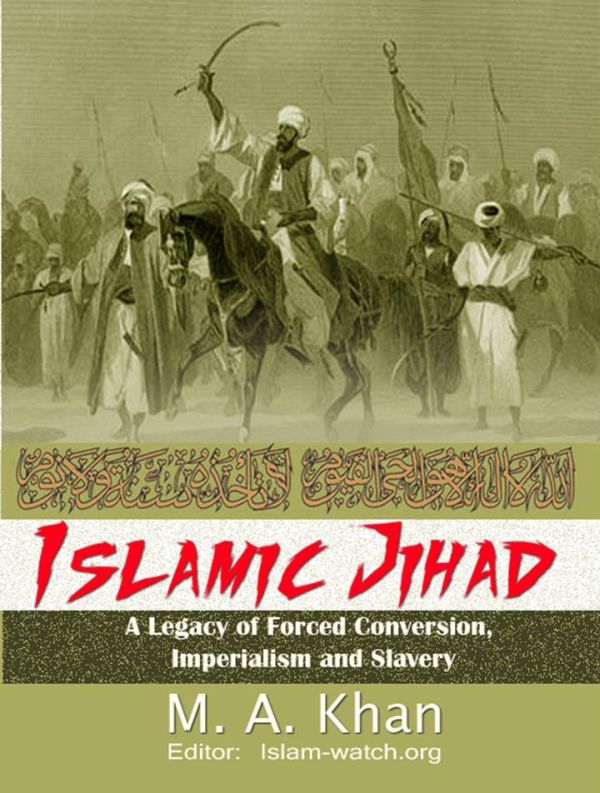The Quran describes Muslims as being nice to each other and harsh against the unbelievers (Q. 48:29 “Muhammad is the Messenger of Allah; and those with him are forceful against the disbelievers, merciful among themselves…”). Some may argue that it is wrong and unfair to look only at the Muslims’ harsh side and make a judgement. This article browses through Islamic history attempt to see how nice the Muslims have been to each other. The following is only a small selection of events that come to mind.
The Quran correctly says that reminders benefit the believers (Q.51:55 “And remind, for indeed, the reminder benefits the believers”). Let us hope that this reminder helps the unbelievers as well, although judging from how the West is dealing with Islamic invasion, this only seems more like a wishful thinking.
The Rashidun (the rightly guided) Era
There are conflicting reports about the nature of Muhammad’s death. Some Muslims insist it was a natural death while others (including Muhammad himself ) believed he was poisoned by a Jewish woman (probably a convert to Islam). Some even accuse Abu Bakr and Omar of plotting to assassinate Muhammad towards the end of his life. The Muslims’ split regarding succession surfaced immediately after their leader’s death and remains unresolved up to the present day. Abu Bakr’s era was marked with the a blood bath ( the Ridda wars) on a scale Arabia never experienced before.
-
The third rightly guided Caliph Uthman, was badly tortured and murdered in a horrific way by fellow Muslims in the year 656 AD. The uprising against Uthman was instigated by Ayesha, who accused him of becoming a kafir who must be killed! Ironically, she later used Uthman’s murder to instigate another uprising against the next Caliph, Ali, whom she accused of being not harsh enough against the murderers.
-
In 656 AD, Ayesha led a failed rebellion against Ali, the fourth rightly guided Caliph. As a result, over ten thousand Muslims were killed by fellow Muslims in the battle of ‘the Camel’.
-
In 657AD, seventy thousands of Muslims were killed by fellow Muslims when Muaweya led a rebellion against the fourth rightly guided Caliph Ali.
-
In 659 AD, the fourth rightly guided Caliph Ali had to suppress another rebellion by fellow Muslims at ‘the Nahrawan’ battle. Again, thousands of Muslims were killed by fellow Muslims.
-
The fourth rightly guided Caliph Ali was murdered by fellow Muslims in 661 AD while praying in a mosque in Kufa (in Iraq)
-
Caliph Al Hassan Ibn Ali ( Muhammad’s grandson) was in effect forced to abdicate only six months after his reign and was poisoned (instigated by Muaweya) and died in Medina in 670 AD
-
Imam Al Hussain Ibn Ali ( Muhammad’s youngest grandson) was killed with vengeance, and beheaded, in 680 AD by Muslim troops acting on order of Yazid Ibn Muaweya. Seventy three members of his family ( almost all of Muhammad’s descendants) were also murdered that same day.
The Umayyad’s Era
-
In 683 AD, 11,000 Muslims were killed by fellow Muslims in Medina. Yazid Ibn Muaweya, the Umayyad Caliph, dispatched his ruthless general Muslim Ibn Ukba to suppress an uprising in Medina. The general “istabaha” (an Islamic term that means “to allow” with no consequent punishment) the city for three days, allowing his soldiers to do whatever they wished of killing, looting etc. Muslim Ibn Ukba converted Muhammad’s mosque, which is the second holiest mosque in Islam, to a stable for his horses to eat, drink, urinate and defecate (imagine if America does that).
-
In 684 AD, the Umayyad army proceeded to Mecca. The Kaaba was bombarded with ‘manjaniq’ (a projectile throwing device, or catapult, used to destroy castles and walls) and burnt.
-
In 685 AD Caliph Marwan Ibn Al Hakam was killed by fellow Muslims.
-
Again in 692 AD, the Umayyad Caliph Abdul Malik Ibn Marwan sent his ruthless general Al Hajjaj Ibn Yousif who surrounded the city of Mecca and bombarded Kaaba with ‘manjaniq’.
-
In 692 Abdulla Ibn Zubair, who was a great Sahaba and highly esteemed figure with many followers in Medina and Mecca (who recognised him as the true Caliph) was killed by fellow Muslims.
-
In 720 AD, the Umayyad Caliph Omar Ibn Abdul Aziz was killed by fellow Muslims.
-
In 740 AD, the Umayyad Caliph Hisham Ibn Abdul Malik ordered the killing of Zaid Ibn Ali (a direct descendant of Muhammad). The body was crucified and placed on the gallows completely naked, some say for years.
-
In 744AD, the Umayyad Caliph Al Waleed Ibn Yazid was killed by fellow Muslims.
-
In 750 AD, the Umayyad Caliph Ibrahim Ibn Al Waleed was killed by fellow Muslims
-
In 750 AD, The last Umayyad Caliph, Marwan II was killed by fellow Muslims
The Abbassid’s Era
-
The first Abbasid Caliph, Abul Abbas Al Saffah (Arabic for butcher) arranged for an “Islamic style” dinner party and invited all the remaining Umayyads for reconciliation and start a new page. He ordered his men to have all of the Umayyads tied and killed (about 300 of them, all Muslims) before serving the first course of dinner to the rest of his Muslim guests.
-
About a thousand years later, Muhammad Ali of Egypt used the same trick to get rid of the Mamluks in Egypt. On first of March 1811 AD, Muhammad Ali invited the Mamluk’s dignitaries for a dinner party at the Citadel in Cairo and killed all of them. The next day, he ordered his soldiers to continue the genocide by hunting the rest of the low ranking Mamluks. Thousands were killed and the Mamluks vanished from Egypt and from history.
-
In 813 AD, the Abased Caliph Al Amin was killed by fellow Muslims working under the command of his brother Al Ma’mun. Scores of Muslims were killed by fellow Muslims as a result of the years-long power struggle between the two brothers.
-
In 861 AD, the Abased Caliph Al-Mutawakkil was killed by a fellow Muslim ( his guard).
-
In 862 AD, the Abased Caliph Al-Muntasir was poisoned and killed by fellow Muslims.
-
In 866 AD, the Abased Caliph Al-Musta’in was killed by fellow Muslims.
-
In 869 AD, the Abased Caliph Al-Mu’tazz was tortured for three days in the scorching heat of midsummer, without water or food, until died.
-
In 870 AD, the Abased caliph Al-Muhtadi was killed by fellow Muslims.
-
In 932 AD, the Abased Caliph Al Muqtadir was slain outside his palace in Baghdad, by fellow Muslims.
-
In 934 AD, the Abased Caliph Al Qahir, was blinded and imprisoned by fellow Muslims. He was released eleven years later to become a beggar in the streets of Baghdad.
-
Before his death in 968 AD, the Abbassid Caliph Al Mutaqi was deposed and blinded by fellow Muslims.
-
The Abbassid Caliph al-Mustakfi,who died in 949 AD, was also deprived of sight and deposed.
The Ottoman’s Era
-
The Ottomans invaded the Middle East, which was already a Muslim land, resulting in the death of tens of thousands of Muslims at the hands of fellow Muslims.
-
In 1389 AD, after the sudden death of the Muslim Ottoman Sultan Murad I, his Muslim son Bayezid arranged for his Muslim brother Yakub to be strangled leaving him the sole claimant to throne.
-
The Muslim Ottoman Sultan Murad II (1404-1451 AD) arrested and killed his young Muslim brother Mustafa.
-
In 1574 AD, Sultan Murad III started his reign by having all his five brothers killed by strangulating them.
-
The Muslim Sultan Mehmed III, who reigned from 1595 to 1603, killed all his Muslim brothers (that is all 19 of them!) to secure power.
The Recent Futuhat (Conquests)
In Islamic terminology, it is wrong to call it invasion or occupation when Muslim armies invade and occupy a non-Muslim country; such actions are called “futuhat”. The word mean ‘openings’ and suggests that the country has now been opened to the Muslims and the blessings of Islam.
By Muhammad’s death, Arabia was already an Islam only region, therefore, all the wars that followed were Muslims vs Muslims wars. Once I read a Saudi account about the unification of the kingdom and was shocked to notice that they actually described their occupation of other towns as ‘futuhat’. The alliance between the house of Saud and the Ikhwan siege Muslim towns like Ta’if, Jedda and Mecca, conquered them, killed thousands of civilians and described their actions as ‘futuhat’. The description suggests that, from the Saudi perspective, the Muslim residents of those towns were actually not Muslims. Indeed, the civilian population of those towns were treated badly and thousands were butchered including women and small children. The Egyptian historian Al Gabarti gave a hair raising description of the Saudi conquest of Ta’if (1803 AD) and the rest of Hijaz. The atrocities of the Saudi/Ikhwan alliance were not limited to the Hijaz region but involved all of Arabia.
Interestingly, the Saudi leadership always sought a religious advice (fatwa) from the council of alma (scholars) before every conquest. Eventually, and after all the blood baths, King Abdul Aziz entered Mecca wearing the robes of Ihram, to comply with Islamic tradition! In preparation for Hajj in 1925 AD, and in keeping with centuries old tradition, the Egyptians sent their expensive ‘mahmal’ that included the hand woven dressing of Ka’aba. As the Egyptians entered the streets of Mecca, they were attacked and massacred by the Ikhwan who thought the Egyptians were not perfectly Islamic as they entered Mecca.
In fact, all the atrocities being committed by ISIS today are replicas of those committed by the Saudi/Ikhwan alliance over the last couple of centuries. No wonder that ISIS calls its occupation of new towns in Iraq and Syria as ‘futuhat’.
The Iraq/Iran war of the 1980s claimed far more losses than the Muslims’ wars against the Persians, the Romans, the Crusaders and the Mongols put together. The current Sunni Vs Shia conflicts may prove to be even worse. The recent Saudi interest in nuclear technology has nothing to do with Israel and everything to do with Iran. It just shows what is in their minds and how far the Muslims are prepared to go to eliminate the other Muslims.



Comments powered by CComment